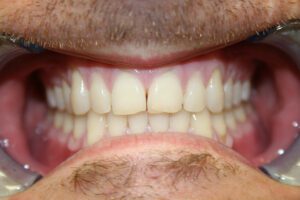
A dental implant is the surgical placement of a fixture in the jaw and its osseointegration with the jawbone to produce an artificial tooth replacement which forms a structural and functional connection between the living bone and the implant.
The abutment is the part screwed to the fixture, providing a sufficient platform above the gum line to retain the prosthesis by means of cement or a screw. Last item is the prosthesis itself and can be in the form of a single crown of an abutment.
There are many advantages of dental implants over fixed bridges.
First, they can be placed with no variation to the structure of the face or jawbone, as is often the case when a tooth is removed. Once the teeth are extracted, and the jawbone is not stimulated by the chewing action, the body resorbs that area of jawbone. Secondly, unlike fixed bridge, the teeth on the each side of the implant need not be cut down as abutments.
Thirdly, fixed bridge requires the existence of tooth on the either sides of the space, whereas, an implant does not need to have a tooth on each side of it. And Implants fill up the gaps across the space because of the missing teeth.
In case of implant, there is no need to have the periodic tooth cleaning between the implants as they are made of metal and porcelain, unlike fixed bridges which often have to be cleaned or replaced due to problems like caries (decay), fractures or nerve diseases. Moreover, no root canal therapy or crown replacement is required in implants.
Although implants are comparatively expensive than fixed bridges initially, but on account of their low cost maintenance, reliability and durability, and the osseointegration success rate of 98.5% makes them much less expensive than fixed bridges which have a mean life expectancy of 10 years. The artificial crown on an implant is removed on being broken and that crown has to be redone only. If in very rare cases the abutment gets fractured, it may be replaced, but the fixture once restored, has never to be replaced.
The expected average life of fixed bridge is of 10 years with 15% to be replaced and around 33% of them may require to be redone by 15 years or so, whereas, implant osseointegration rate of success is of 98.5% with a little percentage of unsuccessful results.
Conclusively, dental Implant saves the patient from spending additional unnecessary and excessive surgical treatment costs due to the individuality of the prosthetic crown (which needs to be replaced in a very rare case of breakage or fracture), thus making implants a more affordable choice for people.

